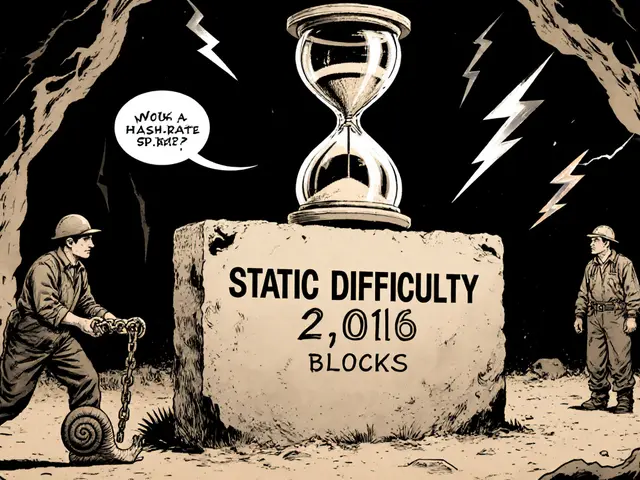
Slashing Insurance Coverage Calculator
Results Summary
Potential Slashing Loss: $0.00
Network: Ethereum
Coverage Type: Full Coverage
Estimated Insurance Coverage: $0.00
Coverage Percentage: 100%
Recommended Action: None
Coverage Details
Key Takeaways
- Slashing is a built‑in penalty in Proof‑of‑Stake (PoS) networks that can wipe out a validator’s staked assets.
- Slashing insurance gives institutions and serious delegators a safety net against downtime, double‑signing, and malicious‑behavior penalties.
- Major providers (Blockdaemon, Figment, DAIC Capital, Luganodes) use different mix of internal reserves, third‑party insurers, and reinsurance to limit exposure.
- Choosing coverage requires matching network‑specific slashing fractions, premium cost, monitoring capabilities, and claim processes.
- The market is expanding fast, with reinsurance giants like MunichRe entering the space, signaling long‑term viability.
What is Slashing in a Proof‑of‑Stake Network?
In a Proof‑of‑Stake (PoS) Network is a blockchain consensus model that selects validators based on the amount of cryptocurrency they lock up as stake. The protocol automatically penalizes misbehaving validators through a process called slashing. When a validator is slashed, a portion-or sometimes the entire-staked amount is permanently burned, reducing the validator’s economic incentive to act honestly.
Three core misbehaviors trigger slashing:
- Missing required block signatures (downtime).
- Signing two conflicting blocks for the same slot (double signing).
- Deliberate attacks or protocol violations classified as malicious behavior.
Because the penalty is automatic and impartial, even well‑intentioned operators can suffer loss if their node goes offline or a software bug causes a double‑sign.
Why Does Slashing Insurance Matter?
For institutional investors, custodians, and large delegators, a single slashing event can wiping out millions of dollars of capital. Traditional risk‑management frameworks expect insurance coverage for operational failures, but PoS slashing is a novel, blockchain‑specific risk. Slashing insurance fills that gap by compensating the affected party up to a predefined percentage of the loss, often covering the full slashing fraction.
Beyond pure financial protection, insurance signals to regulators and internal compliance teams that the staking activity meets enterprise risk‑management standards. It also encourages broader adoption of PoS staking by reducing the fear of catastrophic loss.
Types of Slashing Events Covered
Most providers bundle coverage for three categories:
- Downtime Slashing: Losses when a validator fails to produce a block on time.
- Double Signing: Penalties for signing two different blocks in the same slot, often caused by network partitions or software bugs.
- Malicious Behavior: Deliberate attacks such as attempting to revert transactions or create a fork.
Some insurers also add “soft‑downtime” coverage for brief network glitches that the protocol still treats as a slash, but this is less common.

How Slashing Insurance Works
Insurance contracts are built around the slashing rules of each blockchain. A typical policy defines:
- Coverage limit: The maximum percentage of the slashing loss that will be reimbursed (often 100% for institutional deals).
- Premium: Charged either as a flat fee per epoch or as a small percentage of the total stake.
- Deductible: Some policies set a small floor (e.g., 0.1% of stake) that the client must absorb.
- Claim trigger: Proof of the slashing event from the blockchain’s on‑chain data, often verified by an independent monitoring service.
Providers differ in where the capital comes from:
- Internal self‑funded reserves (e.g., DAIC Capital’s dedicated slashing fund).
- Third‑party specialty insurers (e.g., Chainproof providing primary coverage).
- Reinsurance from global insurers (e.g., MunichRe backing Chainproof’s secondary layer).
Major Providers and Their Approaches
| Provider | Coverage Scope | Primary Model | Secondary/ Reinsurance | Monitoring & Alerts | Typical Premium Structure |
|---|---|---|---|---|---|
| Blockdaemon | 29 PoS assets, all three slashing types | Internal reserves + optional third‑party add‑on | Partners with traditional insurers (undisclosed) | Real‑time dashboard, on‑chain alerts | Enterprise‑negotiated, often bundled |
| Figment | Ethereum double‑sign coverage; other networks via partners | SOC2 & ISO27001 certified infra + NexusMutual partnership | Secondary coverage through NexusMutual | Double Sign Slashing Alerting service | Optional NexusMutual fee (~0.5% of stake) plus service fee |
| DAIC Capital | Downtime slashing only | Dedicated insurance fund (self‑funded) | No external reinsurer disclosed | Continuous uptime monitoring suite | Fund contribution calculated per epoch (≈0.2% of stake) |
| Luganodes | All three slashing types for institutional clients | Automatic inclusion, no extra fee | Chainproof primary, MunichRe secondary | Integrated alerting via Chainproof platform | Included in service contract; no separate premium |
Notice how each player balances internal capital, third‑party insurers, and reinsurance. Selecting the right fit hinges on the networks you stake, your risk tolerance, and whether you prefer a bundled service or a modular add‑on.
How to Choose the Right Slashing Protection
Follow this checklist when evaluating a provider:
- Identify the PoS networks you plan to stake on (Ethereum, Solana, Cosmos, etc.). Verify that the insurer covers each network’s specific slashing fraction.
- Confirm the type of slashing covered. If you run your own validators, downtime coverage is essential; delegators often prioritize double‑sign protection.
- Check the premium and any deductibles. A low premium with a high deductible may not be cost‑effective for large stakes.
- Evaluate monitoring capabilities. Real‑time alerts (e.g., Figment’s Double Sign Slashing Alerting) reduce exposure time.
- Review claim procedures. Look for clear, on‑chain evidence requirements and turnaround times.
- Assess reinsurance backing. Providers backed by insurers like MunichRe have deeper financial buffers for large‑scale events.
Once you’ve narrowed down options, request a sample policy document, run a small pilot (e.g., stake a test amount), and verify claim responsiveness before committing large capital.
Implementation Steps for Institutional Clients
Implementing slashing protection typically follows these phases:
- Risk Assessment: Map out all validator assets, network slashing parameters, and internal risk appetite.
- Provider Selection: Use the checklist above to choose a primary insurer.
- Contract Negotiation: Define coverage limits, premiums, deductibles, and reporting SLA.
- Technical Integration: Connect your validator monitoring stack to the provider’s alert API. For example, Figment’s alerting webhook can be piped into Splunk or PagerDuty.
- Fund Allocation: Set aside premium reserves, often via an on‑chain escrow address.
- Testing: Simulate a downtime event (e.g., temporarily stop a test validator) to ensure the alert and claim workflow works.
- Go‑Live & Ongoing Review: Deploy production validators, monitor performance, and review coverage annually.
Key skills needed include basic PoS knowledge, familiarity with on‑chain data APIs, and standard risk‑management practices.
Future Outlook for Slashing Insurance
The slashing insurance market is still in its early growth stage, but several trends point to rapid maturation:
- Institutional demand will keep rising as banks and custodians seek compliant staking products.
- Reinsurance involvement (MunichRe, Aon) adds credibility and capacity for large‑scale loss events.
- Standardization of policy language is emerging, making cross‑provider comparisons easier.
- Retail‑friendly products may appear as specialty insurers launch lower‑cost options for small delegators.
Potential headwinds include regulatory shifts that could impose additional reporting requirements on staking activities, or a massive slashing incident that strains the reinsurer pool. Overall, the sector looks set to become a core component of any serious PoS staking strategy.

Frequently Asked Questions
What exactly does slashing insurance cover?
Most policies reimburse the portion of staked assets lost due to downtime, double signing, or malicious‑behavior penalties as defined by the underlying blockchain’s slashing rules. Some providers also cover ancillary costs like emergency node replacement.
Do retail stakers have access to slashing protection?
Retail access is limited today, but a few platforms (e.g., NexusMutual) sell individual policies for Ethereum and a handful of other networks. Most coverage is bundled with enterprise‑grade staking services.
How is the premium calculated?
Premiums can be a flat fee per epoch, a percentage of total stake, or a combination of both. The rate depends on the network’s historical slashing frequency, the coverage limit, and whether the policy includes reinsurance.
What role does monitoring play in a claim?
Most insurers require on‑chain proof of the slash-usually a transaction hash and block number-plus a timestamped alert from their monitoring service. Real‑time alerts (like Figment’s) make it easier to submit a timely claim.
Can a single provider cover multiple networks?
Yes. Blockdaemon and Luganodes, for example, list coverage for dozens of PoS assets. However, the depth of coverage (full vs. partial) may vary per network.






There are 15 Comments
Kailey Shelton
Wow, another insurance scam for stakers.
Angela Yeager
Hey folks! If you’re looking into slashing protection, start by checking if the provider monitors your validators in real‑time and offers clear claim procedures. Most reputable services like Figment or Blockdaemon have dashboards that alert you instantly when something goes wrong, which can dramatically reduce downtime loss. Also, compare premium structures – some charge per epoch, others a flat % of stake. Make sure the coverage limit aligns with your risk tolerance; for large institutional stakes, full coverage is usually preferred.
vipin kumar
Don’t trust any of these “insurance” firms – they’re just another way for the crypto elite to skim off your returns while claiming to protect you. The real risk is that the reinsurers behind them are backed by the same hidden cabals that manipulate market data. Keep your nodes offline if you can, that’s the only true safeguard.
Lara Cocchetti
It’s immoral to rely on third‑party insurers while the underlying protocols are designed to punish negligence. By offloading responsibility, you’re encouraging lax operational standards and endangering the network’s security. Choose providers that enforce strict uptime SLAs, or better yet, run your own validators responsibly.
Millsaps Delaine
When contemplating the labyrinthine intricacies of slashing insurance, one must first acknowledge the ontological duality inherent in delegating trust to external entities whilst simultaneously demanding absolute certainty in safeguarding one’s capital. The industry, still nascent as a fledgling sapling in the volatile forest of decentralized finance, has birthed a cadre of providers each touting bespoke coverage matrices, yet the discerning investor must sift through a morass of obfuscatory jargon to discern substantive value. Full‑coverage policies, often marketed with the alluring promise of indemnifying the entirety of a slashing event, invariably embed nuanced exclusions – for instance, “soft‑downtime” or “minor double‑sign” incidents may be relegated to the realm of deductibles, thereby eroding the ostensible protection. Moreover, the premium calculus is not a static figure; it oscillates in concert with network‑specific slashing frequencies, historical loss data, and the reputational capital of the reinsurer, be it MunichRe or an obscure specialty underwriter. A prudent approach mandates an exhaustive audit of the monitoring architecture: does the insurer supply a real‑time alert feed, perhaps via webhook integration into PagerDuty, or does one languish awaiting manual verification that could exacerbate exposure? The claim workflow, too, is a critical vector – on‑chain proof must be marshaled, timestamps authenticated, and a verifiable transaction hash submitted within a narrow window lest the insurer deem the claim stale. It is also judicious to contemplate the liquidity of the insurance fund; does the provider maintain a self‑sustaining reserve, or does it rely on reinsurance layers that may become strained under systemic slashing cascades? One must further interrogate the legal underpinnings: are policy documents governed by jurisdictional statutes that afford recourse, or are they merely cryptic smart‑contract clauses susceptible to interpretive ambiguity? Finally, the strategic alignment of the insurer’s incentives with those of the validator should be scrutinized – an insurer that profits from network stability will arguably prioritize rapid claim settlements, whereas a profit‑centric underwriter may protract the process. In summation, while slashing insurance constitutes a salient instrument for risk mitigation, it demands a rigorous, multi‑dimensional due‑diligence regime, lest the veneer of protection dissolve under the weight of an unforgiving slash.
Jack Fans
Great breakdown! Just adding that you should also verify the insurer’s audit reports – many provide quarterly transparency statements. This can help you gauge the health of their reserve pool. Also, don’t forget to check if the provider offers a grace period for new validators.
Adetoyese Oluyomi-Deji Olugunna
The market is saturated with mediocre policies; only the elite truly understand the nuances of risk transfer. Anyone still paying per‑epoch fees without a bespoke reinsurance backing is, frankly, naïve.
Krithika Natarajan
I appreciate the thorough info. It’s good to see providers focusing on real‑time monitoring and clear claim steps. That makes the whole process less stressful for delegators.
Vaishnavi Singh
Slashing is a reminder that even in decentralized systems, there are built‑in mechanisms that enforce accountability. Insurance, then, becomes a philosophical extension of that very principle.
Linda Welch
So now we have to pay premiums to protect against penalties that were designed to keep us honest? It’s like buying a warranty for a car that already comes with a built‑in safety net, only to have the warranty provider claim they’ll only cover 80% of the damage if the crash was caused by a faulty brake. The whole ecosystem feels like it’s built on layers of bureaucracy that dilute the original ethos of decentralization. Yet the narrative sold to investors is that this is a mature, professional service, and anyone who questions it is dismissed as a Luddite. The more I look at it, the more it seems like an elaborate pyramid where the top firms skim the premiums while the smaller validators bear the risk. If we truly want security, maybe we should focus on improving node reliability rather than outsourcing protection to yet another middle‑man.
Kevin Fellows
Totally get it! Still, having a safety net can give you peace of mind, especially when you’re staking big amounts. 👍
meredith farmer
Listen, every time you hear about “insurance” in crypto, there’s a hidden agenda. They’re pulling the rug right under us while promising a safety blanket. It’s theatrical, and the drama is designed to keep us distracted while the real power structures tighten their grip.
Peter Johansson
Looks like you’ve got a solid point. Just remember, if you’re going to use a provider, keep your validator ops tight and stay on top of alerts. 😊
Cindy Hernandez
For anyone new to this space, I recommend starting with a provider that offers transparent reporting and a straightforward claim process. It can save a lot of headaches later.
Karl Livingston
While the technicalities of slashing insurance can seem overwhelming, it’s essentially about aligning incentives: you protect your stake, the insurer protects their capital, and the network stays robust. Finding that balance is key.
Write a comment
Your email address will not be published. Required fields are marked *